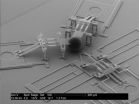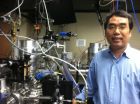(Press-News.org) WASHINGTON D.C. May 13, 2014 -- People standing on a beach often feel the water tugging the sand away from under their feet. This is the undertow, the current that pulls water back into the ocean after a wave breaks on the beach.
Large storms produce strong undertows that can strip beaches of sand. By predicting how undertows interact with shorelines, researchers can build sand dunes and engineer other soft solutions to create more robust and sustainable beaches.
"Formulation of the Undertow Using Linear Wave Theory," a new paper in the journal Physics of Fluids, clears up some of the controversy in undertow modeling, so planners can assess erosion threats faster and more accurately.
The paper's authors are coastal engineer Greg Guannel of the Natural Capital Project, which seeks smarter ways to integrate natural resources into development, and Tuba Ozkan-Haller, an associate professor of coastal engineering at Oregon State University.
Researchers have studied undertow for more than 40 years, and have developed very accurate models of its behavior. The most sophisticated ones are based on Navier-Stokes equations, which describe fluid flow in exquisite detail.
Unfortunately, such precision comes at a price. The mathematics are complex and it takes powerful supercomputers to run them quickly.
"You can't use them to solve day-to-day erosion problems," Guannel said.
For real-world use, researchers need mathematical shortcuts, the engineering equivalent of rounding numbers so they are easier to work with. Researchers turn to linear wave theory, which simplifies things by using idealized forms. Beaches, for example, are wall. Waves are given perfect "S" shapes based on average properties. Instead of modeling everything, researchers make assumptions about some of the weaker forces acting on waves.
"We try to come up with a set of equations that describes flow properties in one step, rather than hundreds of steps, so we can solve problems faster," Guannel said.
Several research teams, each with its own approach, built simplified models based on linear theory. And each came up with a different solution.
This bothered Guannel, who said, "If you start with a single theory, no matter how you approach the problem, you should come up with only one solution, not many."
So Guannel and Ozkan-Haller retraced the work of each team. They found their differences were not due to approach, but to the way they handled weak forces generated by waves. They then developed more consistent ways to describe those forces. The strongest of them was the force exerted by water moving from the top of the wave to the bottom.
"A major advance in our paper was to describe that force correctly," Guannel said.
Another weak force is advection, which occurs as the undertow is sucked into the larger current created by the waves. "In the larger scheme of things, advection of the undertow is weak. But here, it can play an important role," Guannel explained.
"We found that all the differences between researchers were due to the erroneous formulation or the neglect of these weak terms. When we add them back in, everyone who did the math correctly comes up with the same solution," he said.
Instead of debating methodology, researchers can now focus on improving the accuracy of their models. If they can do this, Guannel said, they can build better models to help preserve the shoreline and enable beaches to recover faster after storms.
INFORMATION:
The article "Formulation of the Undertow Using Linear Wave Theory" is authored by G. Guannel and H.T. Özkan-Haller. It appears in the journal Physics of Fluids on May 13, 2014 (DOI: 10.1063/1.4872160). After that date, it can be accessed at: http://scitation.aip.org/content/aip/journal/pof2/26/5/10.1063/1.4872160
ABOUT THE JOURNAL
Physics of Fluids is devoted to the publication of original theoretical, computational, and experimental contributions to the dynamics of gases, liquids, and complex or multiphase fluids. See: http://pof.aip.org
The physics of ocean undertow
Small forces make a big difference in beach erosion, according to new article in Physics of Fluids, which may lead to better solutions for sustainable beaches
2014-05-13
ELSE PRESS RELEASES FROM THIS DATE:
MEMS nanoinjector for genetic modification of cells
2014-05-13
WASHINGTON D.C. May 13, 2014 -- The ability to transfer a gene or DNA sequence from one animal into the genome of another plays a critical role in a wide range of medical research—including cancer, Alzheimer's disease, and diabetes.
But the traditional method of transferring genetic material into a new cell, called "microinjection," has a serious downside. It involves using a small glass pipette to pump a solution containing DNA into the nucleus of an egg cell, but the extra fluid can cause the cell to swell and destroy it—resulting in a 25 to 40 percent cell death rate.
Now, ...
Why athletes are more likely to need pacemakers in old age
2014-05-13
A new study by The University of Manchester has shed light on why athletes are more likely to have abnormal heart rhythms.
Elderly athletes with a lifelong history of training and competing in endurance events like marathons, triathlons and iron man challenges can have heart rhythm disturbances, known as arrhythmias.
The Manchester research in rodents, funded by the British Heart Foundation, shows molecular changes in the heart's pacemaker occur in response to exercise training.
The finding, reported in Nature Communications, overturns the commonly held belief that ...
Study: state VAMS don't reflect content, quality of teachers' instruction
2014-05-13
WASHINGTON, D.C., May 13, 2014—New research published online today in Educational Evaluation and Policy Analysis (EEPA), a peer-reviewed journal of the American Educational Research Association, finds weak to nonexistent relationships between state-administered value-added model (VAM) measures of teacher performance and the content or quality of teachers' instruction. Based on their results, the authors question whether VAM data will be useful in evaluating teacher performance and shaping classroom instruction.
VIDEO: Co-author Morgan S. Polikoff discusses key findings ...
Ultrafast laser technique developed to observe electron action
2014-05-13
University of Central Florida physicist Zenghu Chang has done it again. For a third time this year, his research group has published an article in a Nature journal.
This time, Chang and his team have developed a new ultrafast light source for observing electron motion in molecules – made up of nuclei and electrons – at the point before the nuclei start to move. By being able to observe what actually happens, scientists can begin to understand how an electron interacts with other electrons, which may help improve the efficiency of solar cells.
"The charge migration that ...
Released prisoners are more likely to suffer early death
2014-05-13
Men who have been incarcerated and released are more than twice as likely to die prematurely as those who have not been imprisoned, according to a new study published by Georgia State University criminologist William Alex Pridemore.
Former prisoners are more likely to die early from infectious and respiratory diseases, drug overdoses and homicides. Causes of this "mortality penalty" include increased exposure to diseases like TB and HIV, the prolonged stress of the prison environment, the disruption of important social bonds and, upon release, the struggle to reintegrate ...
Forgiving a wrong may actually make it easier to forget
2014-05-13
We're often told to "forgive and forget" the wrongs that we suffer – it turns out that there may be some scientific truth behind the common saying. A study from researchers at the University of St. Andrews in Scotland shows that the details of a transgression are more susceptible to forgetting when that transgression has been forgiven.
The findings are published in Psychological Science, a journal of the Association for Psychological Science.
"It is well established that learning to forgive others can have positive benefits for an individual's physical and mental health," ...
Signal Fire in New Mexico
2014-05-13
Firefighters are currently battling the Signal Fire in the Gila National Forest in New Mexico. The fire was reported by the Signal Peak Lookout Tower Sunday (May 11) in the afternoon and is located approximately 15 miles north of Silver City. It is currently estimated to be 4,700 acres. The Southwest Area Incident Management Team assumed command of the fire Monday at 6:00 p.m. The cause of the fire is thought to be human either a careless camper or arson, but the investigation is still ongoing. Residents in the vicinity of Signal Peak have evacuated. The firefighters ...
Screening is 'not effective' in the fight against domestic violence
2014-05-13
One in three women around the world have experienced physical or sexual violence from a partner. Although domestic violence is associated with a range of adverse health impacts, even after the abuse has ended, it is not easily identified by health care professionals, prompting some countries, notably the United States, to introduce screening programmes in healthcare settings. A new study, published online by the BMJ today [13 May], has found no evidence to support domestic violence screening.
Researchers from the Universities of Bristol and Melbourne, La Trobe and Columbia ...
Surgery study shows worse health, more problems and higher costs among Medicaid patients
2014-05-13
ANN ARBOR, Mich. — Surgery patients covered by Medicaid come into their operations with worse health, do worse afterward, stay in the hospital longer and find themselves back in the hospital more often than those covered by private insurance, a new analysis by University of Michigan Medical School researchers finds.
In fact, people with Medicaid coverage were twice as likely as other patients to have certain health risk factors before they had surgery, the researchers report in JAMA Surgery. They also had many more emergency operations, experienced two-thirds more complications ...
New cancer immunotherapy aims powerful T cells against tumors
2014-05-13
Deadly skin cancers in mice shrank in response to a new treatment that may complement other "immunotherapies" developed recently to boost the body's own defenses against disease threats, according to a new study published by UC San Francisco researchers in the May 2014 edition of the Journal of Experimental Medicine.
Using a mouse version of a human drug that is popular for treating osteoporosis, the UCSF researchers discovered a way to manipulate the thymus, a gland situated at the base of the neck above the heart, to alter its activity so that some of the specialized ...
LAST 30 PRESS RELEASES:
The Ceramic Society of Japan’s Oxoate Ceramics Research Association launches new international book project
Heart-brain connection: international study reveals the role of the vagus nerve in keeping the heart young
Researchers identify Rb1 as a predictive biomarker for a new therapeutic strategy in some breast cancers
Survey reveals ethical gaps slowing AI adoption in pediatric surgery
Stimulant ADHD medications work differently than thought
AI overestimates how smart people are, according to HSE economists
HSE researchers create genome-wide map of quadruplexes
Scientists boost cell "powerhouses" to burn more calories
Automatic label checking: The missing step in making reliable medical AI
Low daily alcohol intake linked to 50% heightened mouth cancer risk in India
American Meteorological Society announces Rick Spinrad as 2026 President-Elect
Biomass-based carbon capture spotlighted in newly released global climate webinar recording
Illuminating invisible nano pollutants: advanced bioimaging tracks the full journey of emerging nanoscale contaminants in living systems
How does age affect recovery from spinal cord injury?
Novel AI tool offers prognosis for patients with head and neck cancer
Fathers’ microplastic exposure tied to their children’s metabolic problems
Research validates laboratory model for studying high-grade serous ovarian cancer
SIR 2026 delivers transformative breakthroughs in minimally invasive medicine to improve patient care
Stem Cell Reports most downloaded papers of 2025 highlight the breadth and impact of stem cell research
Oxford-led study estimates NHS spends around 3% of its primary and secondary care budget on the health impacts of heat and cold in England
A researcher’s long quest leads to a smart composite breakthrough
Urban wild bees act as “microbial sensors” of city health.
New study finds where you live affects recovery after a hip fracture
Forecasting the impact of fully automated vehicle adoption on US road traffic injuries
Alcohol-related hospitalizations from 2016 to 2022
Semaglutide and hospitalizations in patients with obesity and established cardiovascular disease
Researchers ‘listen in’ to embryo-mother interactions during implantation using a culture system replicating the womb lining
How changing your diet could help save the world
How to make AI truly scalable and reliable for real-time traffic assignment?
Beyond fragmented markets: A new framework for efficient and stable ride-pooling
[Press-News.org] The physics of ocean undertowSmall forces make a big difference in beach erosion, according to new article in Physics of Fluids, which may lead to better solutions for sustainable beaches



